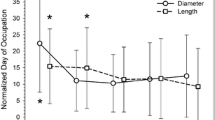Abstract
Tracheal mites have been associated with the condition in honey bees that devastated colonies in Britain and Ireland in the early 1900s. The first outbreak of this condition, that became known as the ‘Isle of Wight’ disease, coincided with the period when brood-cell size was increased from about 5.0 mm to about 5.5 mm in width. We undertook an inoculation experiment over a 7-day period to establish if the act of increasing the brood-cell size could have triggered the onset of tracheal mites in honey bees. The standard-sized cells used had a cell width of 5.44 mm and the small-sized cells a width of 5.07 mm. Using callow (newly emerged) bees, from three colonies that had mixed cell sizes, we compared the susceptibility of bees reared in standard-sized cells with that of those raised in small-sized cells. The results indicated similar levels of female mite abundance (0.49 vs. 0.52 mites per bee) and mean fecundity (4.33 vs. 4.22 offspring per female mite), and produced no evidence of any difference in the overall susceptibility between the bees raised in the standard-sized cells versus small-sized brood cells.
Similar content being viewed by others
References
Adam B (1968) “Isle of Wight” or acarine disease: its historical and practical aspects. Bee World 49:6–18
Bailey L (1958) The epidemiology of the infestation of honeybee, Apis mellifera L., by the mite Acarapis woodi Rennie and the mortality of bees. Parasotology 48:493–506
Bailey L, Ball BV (1991) Honey bee pathology, 2nd edn. Academic Press, London UK, pp 78–96
Cowan TW (1904) The honey bee; its natural history, anatomy and physiology, 2nd edn. Houlston & Sons, London, UK, 220pp
Danka RG, Villa JD (1996) Influence of resistant honey bee hosts on the life history of the parasite Acarapis woodi. Exp Appl Acarol 20:313–322
De Jong D, Morse RA, Eickwork GC (1982) Mite pests of honeybees. Ann Rev Entomol 27:229–252
Erickson EH (1990) Stress and honeybees. Glean Bee Cult 118(3):650–654
Gary NE, Page RE (1987) Phenotypic variation in susceptibility of honey bees, Apis mellifera, to infestation to tracheal mites, Acarapis woodi. Exp Appl Acarol 3:291–305
Gary NE, Page RE, Lorenzen K (1989) Effect of age of worker honey bees (Apis mellifera) on tracheal mites (Acarapis woodi) infestation. Exp Appl Acarol 7:153–160
Giordani G (1977) Facts about acarine mites. In: Proc Int Congr Apicult XXVI, Adelaide, Australia, pp 459–467
Hatjina F, Gregorc A, Papaefthimiou C, Pappas N, Zacharioudakis S (2004) Differences in the morphology of prothoracic and propodeal spiracles in three strains of Apis mellifera: possible relation to resistance against Acarapis woodi. J Apicult Res 43(3):105–113
Komelli AB, Ambrose JT (1991) Electron microscope studies of the tracheae and flight muscles of noninfested, Acarapis woodi infested and crawling honey bees Apis mellifera. Am Bee J 131:253–257
Lee DC (1963) The susceptibility of honey bees of different ages to infestation by Acarapis woodi (Rennie). J Insect Pathol 5:11–15
McMullan JB, Brown MJF (2005) Brood pupation temperature affects the susceptibility of honeybees (Apis mellifera L.) to infestation by tracheal mites (Acarapis woodi). Apidologie 36:97–105
McMullan JB, Brown MJF (in press) Influence of small-cell brood comb on the morphometry of honeybees (Apis mellifera L.). Apidologie
Morgenthaler O (1930) New investigations on acarine disease. Bee World 11:49–50
Nasr ME, Otis GW, Scott-Dupree CD (2001) Resistance to Acarapis woodi by honey bees (Hymenoptera: Apidae): divergent selection and evaluation of selection process. J Econ Entomol 94:332–338
Page RE, Gary NE (1990) Genotypic variation in susceptibility of honey bees (Apis mellifera) to infestation by tracheal mites (Acarapis woodi). Exp Appl Acarol 8:275–283
Pettis JS, Wilson WT (1989) Reproduction of Acarapis woodi as related to seasonal host longevity. Am Bee J 129:820
Rennie J (1921) Isle of Wight disease in hive bees—acarine disease: the organism associated with the disease—Tarsonemus woodi. Trans R Soc Edinburgh 52:768–779
Shimanuki H, Knox DA (2000) Diagnosis of honey bee diseases. Agriculture Handbook No. 690. U.S. Department of Agriculture
Sokal RR, Rohlf FJ (1995) Biometry. WH Freeman and Company, New York, pp 413–415
Acknowledgements
The authors would like to thank the members of Fingal North Dublin Beekeepers’ Association and John & Dorothy Stapleton for access to honey bee colonies. Comments from the editor and two anonymous reviewers helped to improve the clarity of the manuscript.
Author information
Authors and Affiliations
Corresponding author
Rights and permissions
About this article
Cite this article
McMullan, J.B., Brown, M.J.F. Brood-cell size does not influence the susceptibility of honey bees (Apis mellifera) to infestation by tracheal mites (Acarapis woodi). Exp Appl Acarol 39, 273–280 (2006). https://doi.org/10.1007/s10493-006-9017-2
Received:
Accepted:
Published:
Issue Date:
DOI: https://doi.org/10.1007/s10493-006-9017-2




